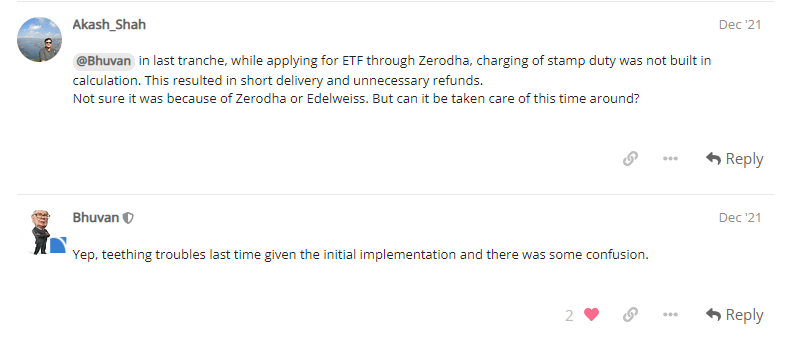The NFO of Bharat Bond ETF & Fund Of Fund (FOF) 2033 maturity opens for subscription on December 2, 2022. Bharat Bond is a debt ETF that will only hold bonds issued by public sector undertakings (PSUs). Unlike traditional ETFs which don’t have an expiry, Bharat Bond is a target maturity ETF that will expire. In this case, in 2033.
In case you missed it, Do check out our previous TQnA post to know everything about the Bharat Bond ETF issue ![]()
If you are new to all this and have no clue about ETFs, check out this Varsity chapter👇
What is the Bharat Bond ETF?
Bharat bond ETF is a debt exchange-traded fund (ETF) that will only invest in AAA bonds issued by PSU companies owned by the Government Of India.
What will the ETF hold?
The ETF will only hold bonds with AAA credit ratings issued by the Government of India-owned companies such as REC, PFC, NHAI, etc.
What do you mean by target maturity?
When you buy a traditional ETF like a Nifty ETF, it doesn’t have a maturity date, you can hold it for as long as you want. But the Bharat Bond ETFs use a target maturity structure, meaning they have a fixed maturity date, just like a normal bond. So in this case, the ETF will mature in 2033, and you’ll get the maturity amount in your bank account. This structure is called target maturity.
How safe is the ETF?
Two of the biggest risks in bonds are default risk and interest rate risk.
-
Default risk: It’s the risk of a company not paying back its debt. Since the ETF will only hold bonds issued by PSUs, there is very minimal default risk. PSU bonds carry an “implicit sovereign guarantee.” Meaning, the Govt doesn’t explicitly say that it guarantees the debt, but it is understood that if something goes wrong the Govt will step in.
-
Interest risk: Bond price and interest rates have an inverse relationship. Interest rate risk is the market risk you have to bear due to interest rate changes. As interest rates rise and fall, the yields of the underlying bonds will rise and fall and by extension the price of the ETF. However, if you are holding the ETF until maturity, interest rate risk won’t matter to you.
Check out the chapter on debt funds to understand more
How will the interest payments be paid?
The coupons in the ETF will be reinvested. And once the ETF matures, the entire proceeds will be paid out to you.
What will be the expense ratio of the ETF?
0.0005%
Can I sell the ETF before maturity?
Yes, you can, just like any other ETF. But a general word of caution, there might be some liquidity risk in ETFs given that ETFs aren’t really all that popular in India. By liquidity risk I mean, the difference between bids and offers. You can avoid this by placing limit orders.
What is the minimum and maximum amount I can invest?
For retail investors, the minimum investment amount is Rs. 1,001 and in multiples of Rs. 1 thereafter, with the maximum investment amount being Rs. 2,00,000.
For Non-Institutional Investors, Retirement funds, and QIBs, the minimum investment amount is Rs. 2,00,001 and in multiples thereof.
What returns can I expect?
The yield of the 2033 ETF is 7.67% if held to maturity.
What will be the taxation on this ETF?
If sold within 3 years, it will be considered short-term and STCG as per your income slab will be applicable. If sold after 3 years it will be considered as long term and an LTCG of 20% with indexation is applicable.
Constituents of the ETF.
The ETF/FOF will track the Nifty Bharat Bond 2033 index
| Index Name | Yield | Residual Maturity | Macaulay’s Duration |
|---|---|---|---|
| Nifty BHARAT Bond Index – April 2033 | 7.67% | 9.95 | 7.15 |
Maturity date: 18th April 2033
ETF/FOF yield: 7.67% if held to maturity.
Modified duration: 6.67 years
When is the issue opening and how can I buy Bharat Bond ETF?
The NFO opens on December 2nd and closes on December 8th,2022.
You can invest in Bharat Bond ETF here.
You’ll not be able to invest in Bharat Bond FOF on Coin since NFOs are temporarily not available on Coin as we are transitioning to a new transaction processing system. You can invest in FOF once the fund opens for continuous purchase within a week of the NFO closing.
Index only portfolio
The other advantage is for index fund investors. With Bharat bond ETFs, you can now build a pure index only portfolio.
ETF/FOF Holdings
| Sr. No. | Issuer | Ratings | Wt. (%) |
|---|---|---|---|
| 1 | NATIONAL BANK FOR AGRICULTURE AND RURAL DEVELOPMENT | AAA | 15.00% |
| 2 | NATIONAL HIGHWAYS AUTHORITY OF INDIA | AAA | 15.00% |
| 3 | POWER FINANCE CORPORATION LIMITED | AAA | 15.00% |
| 4 | REC LIMITED | AAA | 15.00% |
| 5 | INDIAN RAILWAY FINANCE CORPORATION LIMITED | AAA | 14.95% |
| 6 | NTPC LIMITED | AAA | 11.00% |
| 7 | EXPORT-IMPORT BANK OF INDIA | AAA | 9.94% |
| 8 | POWER GRID CORPORATION OF INDIA LIMITED | AAA | 3.28% |
| 9 | NHPC LIMITED | AAA | 0.82% |
| Total | 100.00% |
Let us know if you guys have any questions.
